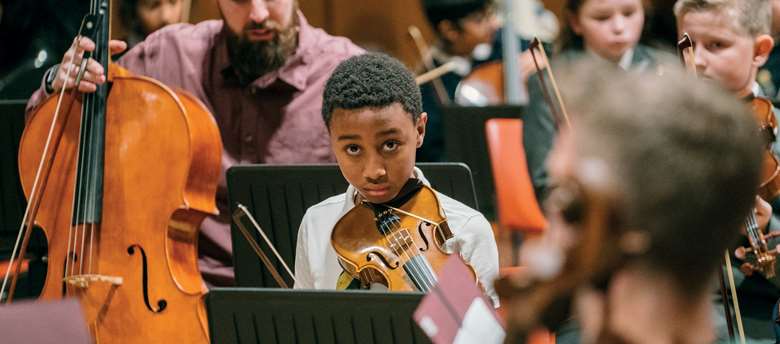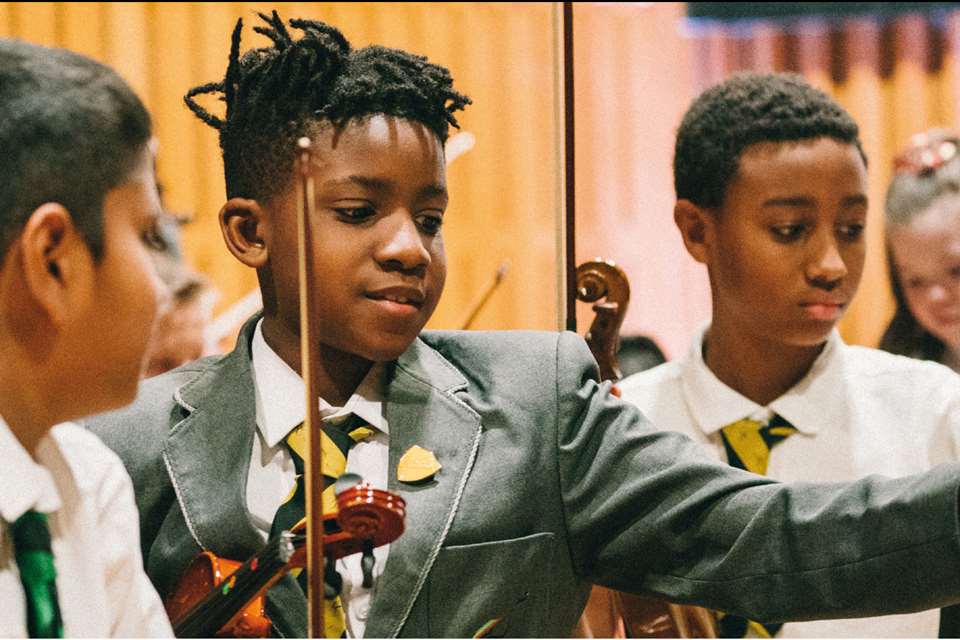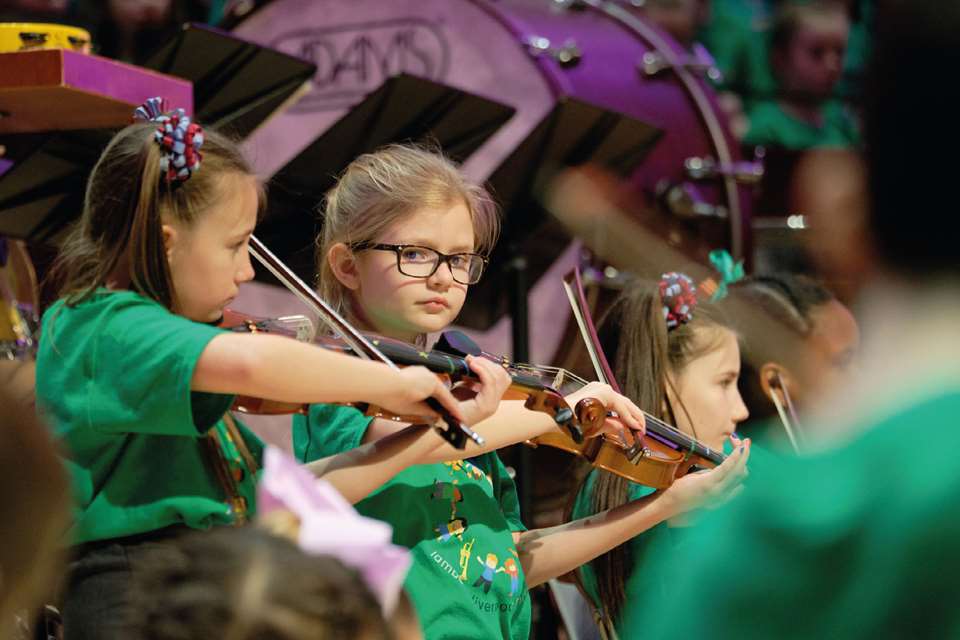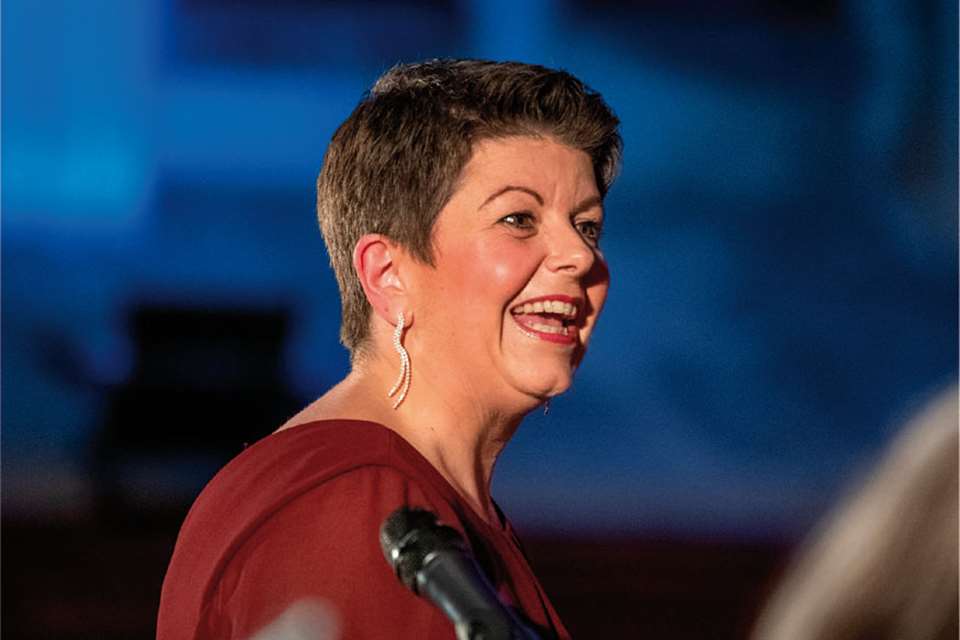Group strings teaching with In Harmony Opera North
Stephen Laidlaw
Sunday, October 1, 2023
In this case-study looking at First Access strings, Stephen Laidlaw of In Harmony Opera North shares ideas from their curriculum.

Tom Arber
In Harmony Opera North launched in the spring of 2013 at Windmill Primary School, Leeds. It now takes place at six primary schools and one secondary school in Leeds and Halifax, involving over 2,500 in full-time education on a weekly basis. In Harmony brings weekly music lessons and performance opportunities to its partner schools through the First Access programme, during the school day. The schools also have opportunities to interact with the Opera Company as an audience. Underpinning this work is a desire to enrich communities and to foster a love of the arts as well as the musical potential of students.
Primary First Access
String pedagogy is a headline feature of our Primary First Access, which lasts from Reception to Year 6; 50% of students will play a string instrument for four of these seven years. Students normally access three years of general musicianship and two years of strings, before half continue with strings and the other half move to brass:
| Age/Year group | (During school time) |
| Reception | In Harmony; General musicianship classes |
| Year 1 | |
| Year 2 | |
| Year 3 | In Harmony: All students learn violin, viola or cello and access choir sessions |
| Year 4 | |
| Year 5 | In Harmony: All students learn violin, viola, cello, trumpet, French horn or trombone |
| Year 6 |
Within the first four years, students make significant progress on their instrument, and develop skills in reading, listening and appraising, not to mention ensemble work.
The In Harmony Opera North team provides a unique laboratory: a group of tutors working together day-in, day-out, sharing ideas and methodologies; testing strategies and comparing notes on the successes or challenges. As the programme grew, we began to see how certain repertoire and pedagogy formed a greater challenge for some instruments over others. With questions around notation too, we felt the need to develop an in-house methodology, one that would suit our wide-range of settings (and growing cohort). This work became the bedrock of developments after 2020.
The mini-orchestra
Instrumental sessions now take place as a mini orchestra, where three instruments have lessons at the same time: violin, viola and cello. This is perhaps a unique format, which has been well served by standardising repertoire choices and developing a teaching language free from instrument bias. For example, we have developed a five-point sequence for students to find the correct postures in ‘playing position’. Some instructions will be familiar to most string teachers (e.g. ‘rest position’, ‘stop the traffic’), but the key to these is the clearly-defined objective of each step that is relevant to all instruments (simultaneously). This sequence also considers the gross-to-fine motor skills that students must have in order to play, which links to students’ physical and kinesthetic development.
These core instructions are used consistently, until Year 6, to maintain early proficiency and provide familiar structures to sessions throughout the project. The sequence also doubles as an award scheme: each student can collect ‘bow badges’ by demonstrating their proficiency at each instruction before progressing to learn how to use the bow.
Teaching the bow in this setting is one of the trickiest elements, given there are so many differences between upper-strings and lower-strings pedagogy. Creating instructions that were meaningful to each instrument, therefore, was a real challenge. However, we now use a sequence of ‘Belly-Button Bow’, ‘L-shaped Thumb’ and ‘Flip’ to the string, which gives students time to develop the muscle memory for a relaxed and natural bow-hold, without lots of individually-tailored instructions.
Kodály
In addition to considering how the mechanics of learning can be optimised for the mini orchestra, a hallmark of our curriculum is its Kodály-inspired approach. In writing the curriculum, it was decided that this ‘takes place via the instrument’ rather than ‘starts from the instrument’. This distinction encapsulates the long-term goals of the project: to build general musical skills that can be applied to any instrument or musical situation that the students encounter throughout their musical journeys.
As the students start to learn instruments, after three years of Kodály-inspired musicianship, we work hard to harness the skills that they have acquired by this time. Two fundamental features that derive from Kodály’s methodology are using the voice throughout learning, and the sequence ‘prepare, present, practise’.
The voice is used because everyone has this instrument, everyone can learn to sing. During their previous music sessions, students practised using the voice during musicianship exercises. Therefore, singing-before-playing comes naturally, as do sung instructions, spoken rhythms (with rhythm syllables) and vocal sol-fa when used during string lessons.
‘Prepare, present, practise’ denotes Kodály’s belief that children learn best when learning about something that they have already experienced subconsciously or when using a familiar song. A large part of Kodály’s practice involved collecting folk songs and nursery rhymes that he could then use in education, progressively.
Notation
Following this principle, we have designed a method of teaching notation which takes familiar songs and re-examines them in an instrumental context, while simultaneously stretching students’ reading skills to a higher level than initially required. By integrating the Kodály-inspired reading tools, sol-fa and progressive stave-reading work, we have observed a huge increase in the musical literacy of students.
Here is an example of the approach. Example 1 shows the pattern ‘mi mi re re do sh’ with do in a space, which the students will read and sing. Example 2 shows the pattern ‘do do so so do sh’ that can be played on instruments, using open strings (pizzicato or arco).

Ex.1 
Ex.2
Note:
- a three-line stave is used, which links to the previous years’ work. In Year 2, a three-line stave is used for notes ‘so’, ‘mi’ and ‘la’. In Year 3, students learn to read notes ‘re’ and ‘do’ also, before transitioning to the five-line stave. Clefs are introduced later in Year 3, after students have learnt a full octave of notes and how to read time- and key-signatures.
- The note ‘do’ sometimes appears on a line and sometimes in a space, to increase the versatility of the student using the stave and to remove instrumental bias.
These two patterns can then be combined, by playing and singing simultaneously or by duetting with the tutor or another student. The significance of this dual approach is the developing understanding of how lines and spaces function on the stave. This builds a fuller picture of learning to read music, as well as just playing it. Everything in the method that is read by students is also heard, sung, moved- to and played; it aims to fully integrate the teaching of musicianship, literacy and instrumental pedagogy.
Repertoire
As per Kodály’s logic, we use familiar repertoire, including short musicianship songs, nursery rhymes and modern songs that students request. Traditional orchestral and opera repertoire is also a great source of inspiration. Last year saw a cross-school composition project inspired by Mozart’s Requiem, and next year we include ‘Mars’ from The Planets, in conjunction with the Orchestra of Opera North’s performance of the work.
Our string sessions also draw on fantastic material such as Team Strings, Fiddle Time Starters and Vamoosh, which all play a valuable part. Using this repertoire can lead to exciting places. For our 10th anniversary concert (December 2022), we commissioned George Morton to ‘recompose’ backing-tracks for works by authors Thomas Gregory and Kathy and David Blackwell, for the Orchestra of Opera North to perform with In Harmony students. This was a very exciting and valuable opportunity for all involved, and we hope to create many similar experiences over the next 10 years!




